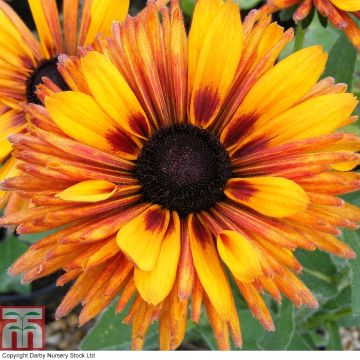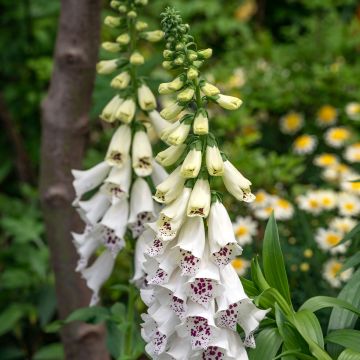

Rudbeckia hirta Goldilocks Seeds
Rudbeckia hirta Goldilocks Seeds
Rudbeckia x hirta Goldilocks
Black-eyed Susan, Gloriosa Daisy, Yellow Ox-eye Daisy
Special offer!
Receive a €20 voucher for any order over €90 (excluding delivery costs, credit notes, and plastic-free options)!
1- Add your favorite plants to your cart.
2- Once you have reached €90, confirm your order (you can even choose the delivery date!).
3- As soon as your order is shipped, you will receive an email containing your voucher code, valid for 3 months (90 days).
Your voucher is unique and can only be used once, for any order with a minimum value of €20, excluding delivery costs.
Can be combined with other current offers, non-divisible and non-refundable.
Home or relay delivery (depending on size and destination)
Schedule delivery date,
and select date in basket
This plant carries a 6 months recovery warranty
More information
We guarantee the quality of our plants for a full growing cycle, and will replace at our expense any plant that fails to recover under normal climatic and planting conditions.
Would this plant suit my garden?
Set up your Plantfit profile →
Description
The 'Goldilocks' Rudbeckia is a short-lived perennial plant but fast-growing and highly floriferous, most often grown as an annual. Its heads are composed of a semi-double to double collar of intense golden yellow, arranged around a central cone of black colour. Despite its modest size, this variety offers a generous flowering, which renews from the heart of summer until late autumn, with new flowers hiding their fading predecessors. It can be admired up close in bouquets, where its flowers are very long-lasting, and in flowerpots or flower beds. Easy to grow, this plant thrives in full sun and ordinary soil, moist to occasionally dry.
The annual 'Goldilocks' rudbeckia belongs to the Asteraceae family. Its ancestor, Rudbeckia hirta, also known as Hairy Coneflower, is a short-lived perennial native to the United States. There, it grows in meadows, pastures, and cultivated fields where it is considered an adventive.
'Goldilocks' is a compact and particularly floriferous cultivar. It is a herbaceous plant that develops primarily unbranched stems covered with large, stiff hairs that are slightly rough to the touch. Reaching 50 to 60 cm (20 to 24in) in height when in bloom, with a spread of 38cm (15in), the plant has an erect and bushy habit. The flowers bloom from July to October. Each head consists of a central disk shaped like a flattened and rounded cone, composed of numerous almost black tubular flowers. This cone is surrounded at the base by a collar of dark yellow to orange ligulate flowers, more or less double. The lower leaves, ovate and pointed, about 10 cm (4in) long, with toothed edges, appear in basal tufts. The leaves of the stems, called cauline leaves, are smaller and sessile (without petioles), with a rounded to cordate base.
Both an architectural plant and an accent plant, the Hairy Coneflower quickly structures your flower beds and fits well in flowerpots thanks to its compact and round habit, offering excellent flowering without restraint. Its strong presence, due to the contrast of colours, requires it to be associated with plants with light flowering, such as evening primroses (Oenothera versicolor Sunset Boulevard), Felicitas, nemesis, or lobelias in flowerpots. In a countryside garden, mix it, for example, with inulas, Ammi visnaga, or ornamental carrots. Its sunny flowers will also be enhanced by the architectural design of tall miscanthus, such as Miscanthus sinensis Yaku-Jima, Silberspinne, and transmorrisonensis.
All Rudbeckias are dye plants (especially R. hirta and R. laciniata) due to the presence of molecules called flavonols in their tissues. The inflorescences yield yellow-orange colours, while the entire plant provides yellow-green shades.
An ecological asset: Throughout the summer, the nectar-rich flowers of Rudbeckias attract pollinating insects and butterflies to your garden. It is a good way to improve your garden's ecosystem and promote fruit and vegetable production in your vegetable patch. In autumn, you can admire the ballet of birds that come to feed on the mature seeds they find in the hearts of dried flowers.
Report an error about the product description
Flowering
Foliage
Plant habit
Botanical data
Rudbeckia
x hirta
Goldilocks
Asteraceae
Black-eyed Susan, Gloriosa Daisy, Yellow Ox-eye Daisy
Cultivar or hybrid
Other Rudbeckia seeds
View all →Planting and care
Before sowing the rudbeckia, place your seeds in the vegetable compartment of your refrigerator for 4 weeks. This will break the seed's dormancy and improve your sowing's success.
Sow the seeds from February to April in a seed tray. Use a good quality compost that you will sieve on the surface to bind the seed to its substrate. Before sowing, gently press down the compost with a board. Sow your seeds by broadcasting. Cover the seeds by sprinkling compost on top or using vermiculite, gently press down and water generously with a fine rain. Place your seed tray in a well-lit area, without direct sunlight, at a temperature of 20°C (68°F) to 25°C (77°F). Lower the temperature at night to 18°C (64.4°F) to create a beneficial alternation for germination.
The seeds will germinate in 10 to 21 days. When the seedlings are manageable, transplant them into 7cm (3in) pots. Keep the compost moist but not excessively during growth. Then, 15 days before their final planting, start gradually acclimating them to a temperature of 15°C (59°F).
By the end of May or early June, the temperature in the garden will be warm enough to plant your young plants. Choose a sunny location. Add a good shovel of compost to each planting hole. Space your plants 30 cm (12in) apart.
Regularly remove faded flowers to maintain their beauty and promote repeat flowering.
Sowing period
Intended location
This item has not been reviewed yet - be the first to leave a review about it.
Similar products
Haven't found what you were looking for?
Hardiness is the lowest winter temperature a plant can endure without suffering serious damage or even dying. However, hardiness is affected by location (a sheltered area, such as a patio), protection (winter cover) and soil type (hardiness is improved by well-drained soil).

Photo Sharing Terms & Conditions
In order to encourage gardeners to interact and share their experiences, Promesse de fleurs offers various media enabling content to be uploaded onto its Site - in particular via the ‘Photo sharing’ module.
The User agrees to refrain from:
- Posting any content that is illegal, prejudicial, insulting, racist, inciteful to hatred, revisionist, contrary to public decency, that infringes on privacy or on the privacy rights of third parties, in particular the publicity rights of persons and goods, intellectual property rights, or the right to privacy.
- Submitting content on behalf of a third party;
- Impersonate the identity of a third party and/or publish any personal information about a third party;
In general, the User undertakes to refrain from any unethical behaviour.
All Content (in particular text, comments, files, images, photos, videos, creative works, etc.), which may be subject to property or intellectual property rights, image or other private rights, shall remain the property of the User, subject to the limited rights granted by the terms of the licence granted by Promesse de fleurs as stated below. Users are at liberty to publish or not to publish such Content on the Site, notably via the ‘Photo Sharing’ facility, and accept that this Content shall be made public and freely accessible, notably on the Internet.
Users further acknowledge, undertake to have ,and guarantee that they hold all necessary rights and permissions to publish such material on the Site, in particular with regard to the legislation in force pertaining to any privacy, property, intellectual property, image, or contractual rights, or rights of any other nature. By publishing such Content on the Site, Users acknowledge accepting full liability as publishers of the Content within the meaning of the law, and grant Promesse de fleurs, free of charge, an inclusive, worldwide licence for the said Content for the entire duration of its publication, including all reproduction, representation, up/downloading, displaying, performing, transmission, and storage rights.
Users also grant permission for their name to be linked to the Content and accept that this link may not always be made available.
By engaging in posting material, Users consent to their Content becoming automatically accessible on the Internet, in particular on other sites and/or blogs and/or web pages of the Promesse de fleurs site, including in particular social pages and the Promesse de fleurs catalogue.
Users may secure the removal of entrusted content free of charge by issuing a simple request via our contact form.
The flowering period indicated on our website applies to countries and regions located in USDA zone 8 (France, the United Kingdom, Ireland, the Netherlands, etc.)
It will vary according to where you live:
- In zones 9 to 10 (Italy, Spain, Greece, etc.), flowering will occur about 2 to 4 weeks earlier.
- In zones 6 to 7 (Germany, Poland, Slovenia, and lower mountainous regions), flowering will be delayed by 2 to 3 weeks.
- In zone 5 (Central Europe, Scandinavia), blooming will be delayed by 3 to 5 weeks.
In temperate climates, pruning of spring-flowering shrubs (forsythia, spireas, etc.) should be done just after flowering.
Pruning of summer-flowering shrubs (Indian Lilac, Perovskia, etc.) can be done in winter or spring.
In cold regions as well as with frost-sensitive plants, avoid pruning too early when severe frosts may still occur.
The planting period indicated on our website applies to countries and regions located in USDA zone 8 (France, United Kingdom, Ireland, Netherlands).
It will vary according to where you live:
- In Mediterranean zones (Marseille, Madrid, Milan, etc.), autumn and winter are the best planting periods.
- In continental zones (Strasbourg, Munich, Vienna, etc.), delay planting by 2 to 3 weeks in spring and bring it forward by 2 to 4 weeks in autumn.
- In mountainous regions (the Alps, Pyrenees, Carpathians, etc.), it is best to plant in late spring (May-June) or late summer (August-September).
The harvesting period indicated on our website applies to countries and regions in USDA zone 8 (France, England, Ireland, the Netherlands).
In colder areas (Scandinavia, Poland, Austria...) fruit and vegetable harvests are likely to be delayed by 3-4 weeks.
In warmer areas (Italy, Spain, Greece, etc.), harvesting will probably take place earlier, depending on weather conditions.
The sowing periods indicated on our website apply to countries and regions within USDA Zone 8 (France, UK, Ireland, Netherlands).
In colder areas (Scandinavia, Poland, Austria...), delay any outdoor sowing by 3-4 weeks, or sow under glass.
In warmer climes (Italy, Spain, Greece, etc.), bring outdoor sowing forward by a few weeks.



















































